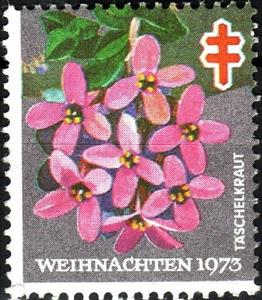Stamp: Christmas 1973 Taschelkraut (Germany, Federal Republic 1973)
Christmas 1973 Taschelkraut (Germany, Federal Republic 1973)
01 January (Germany, Federal Republic ) within release Tuberculosis Charity goes into circulation Stamp Christmas 1973 Taschelkraut face value None No Face Value
| Stamp Christmas 1973 Taschelkraut in catalogues | |
|---|---|
| Colnect codes: | Col: DE 1973-03 |
Stamp is vertical format.
Also in the issue Tuberculosis Charity:
- Stamp - Christmas 1973 - Fetthenne face value None;
- Full Pane - Christmas 1973 face value None;
- Se-tenant - Christmas 1973 face value None;
- Se-tenant - Christmas 1973 face value None;
- Souvenir Sheet - Christmas 1973 Bayern face value None;
- Souvenir Sheet - Christmas 1973 Bayern face value None;
- Stamp - Christmas 1973 Mauerpfeffer face value None;
- Stamp - Christmas 1973 Steinbrech face value None;
- Stamp - Christmas 1973 Taschelkraut face value None;
Stamp Christmas 1973 Taschelkraut it reflects the thematic directions:
help, especially in the form of money, given freely to people who are in need, for example because they are ill, poor, or have no home, and organizations that provide this help: She does a lot of work for charity.
A flower, sometimes known as a bloom or blossom, is the reproductive structure found in plants that are floral (plants of the division Magnoliophyta, also called angiosperms). The biological function of a flower is to effect reproduction, usually by providing a mechanism for the union of sperm with eggs. Flowers may facilitate outcrossing (fusion of sperm and eggs from different individuals in a population) or allow selfing (fusion of sperm and egg from the same flower). Some flowers produce diaspores without fertilization (parthenocarpy). Flowers contain sporangia and are the site where gametophytes develop. Many flowers have evolved to be attractive to animals, so as to cause them to be vectors for the transfer of pollen. After fertilization, the ovary of the flower develops into fruit containing seeds. In addition to facilitating the reproduction of flowering plants, flowers have long been admired and used by humans to beautify their environment, and also as objects of romance, ritual, religion, medicine and as a source of food.
Flora is the plant life occurring in a particular region or time, generally the naturally occurring or indigenous—native plant life. The corresponding term for animal life is fauna. Flora, fauna and other forms of life such as fungi are collectively referred to as biota. Sometimes bacteria and fungi are also referred to as flora, as in the terms gut flora or skin flora.



